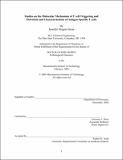Studies on the molecular mechanism of T cell triggering and detection and characterization of antigen-specific T cells
Author(s)
Stone, Jennifer Drignat, 1976-
DownloadFull printable version (6.356Mb)
Other Contributors
Massachusetts Institute of Technology. Dept. of Chemistry.
Advisor
Lawrence J. Stern.
Terms of use
Metadata
Show full item recordAbstract
(cont.) Identification and characterization of T cell epitopes derived from infectious agents or vaccines can greatly enhance the ability to study and eventually direct the immune response. This work contains a description of a novel technique for identifying and characterizing specific T cell responses in parallel. The system involves incubating heterogeneous T cell mixtures with artificial antigen-presenting microarrays, which include immobilized cytokine capture antibodies, co-stimulatory molecules, and MHC complexes presenting many different potential T cell epitope peptides. These microarrays can rapidly, conveniently, and sensitively detect antigen-specific T cells and characterize the functional responses to many different epitopes in parallel in a location-dependent manner. T cells recognize cognate peptide antigen in complex with major histocompatibility complex (MHC) proteins; however, the molecular events which trigger T cells upon binding of MHC-peptide to the T cell receptor (TCR) are unclear. To gain a better understanding of this mechanism, CD4+ T cells were treated with soluble class II MHC-peptide monomers and oligomers instead of antigen-presenting cells, and the activation response was monitored. These experiments showed a requirement for multivalent TCR engagement to induce activation. Mathematical modeling of oligomeric equilibrium binding states indicates that the level of the T cell response correlates with the predicted number of receptor cross-links formed by soluble MHC oligomers. Treatment of CD8+ T cells with class I MHC monomers and oligomers revealed a confusing process whereby peptide derived from soluble MHC reagents was loaded on to endogenous MHC complexes on the T cell surface and re-presented to other cells. When this method of stimulation was circumvented, multivalent TCR engagement was found to be required for CD8+ T cell activation, similar to CD4+ T cells. In both types of cells, monomeric MHC-peptide binding can compete off activation responses induced by MHC-peptide oligomers in the same mixture, further emphasizing the non-productive nature of monovalent TCR engagement. However, exquisite antigen sensitivity might be achieved on the surface of an APC due to the contribution of non-activating MHC-peptide complexes. Even though solubme monomeric MHC does not cause activation, soluble heterodimeric MHC-peptide ligands with only one activating peptide induce T cell activation responses.
Description
Thesis (Ph. D.)--Massachusetts Institute of Technology, Dept. of Chemistry, February 2005. This electronic version was submitted by the student author. The certified thesis is available in the Institute Archives and Special Collections. Vita. Includes bibliographical references (leaves 130-143).
Date issued
2005Department
Massachusetts Institute of Technology. Department of ChemistryPublisher
Massachusetts Institute of Technology
Keywords
Chemistry.